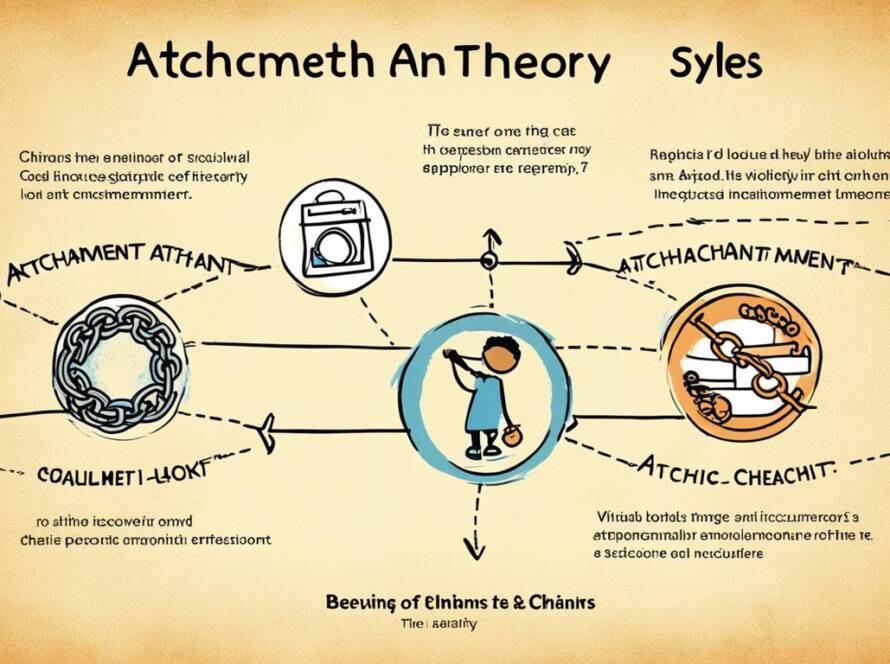The goal of every parent is to give our children a head start at a healthy happy life. for most of us the blueprint for our parenting journey has already been set deep in the roots of our own family tree. Utilizing attachment theory in
As a parent, nurturing your child’s secure attachment development is a crucial aspect of their emotional well-being and healthy relationships throughout their life. By creating a strong emotional bond and trust in the parent-child relationship, parents can lay the foundation for a secure attachment style. In this article, we will explore practical tips and strategies for parents to foster secure attachment development in their children.
Key Takeaways:
- Building a strong emotional bond and trust is essential for secure attachment development.
- Creating an emotionally supportive environment is the first step towards enhancing the parent-child relationship.
- Being a secure base and responding to your child’s needs contribute to trust-building and a sense of security.
- Positive interactions and play are essential for bonding and strengthening the parent-child relationship.
- Consistency and setting appropriate boundaries create a secure and predictable environment for your child.
Understanding Secure Attachment Theory
Secure attachment theory is a key concept to understand when it comes to your child’s emotional development. At its core, secure attachment refers to the emotional bond and trust established between a child and their primary caregiver.
Research has shown that secure attachment is crucial for a child’s emotional well-being, with long-lasting effects impacting their ability to form healthy relationships throughout their lifetime.
There are four primary attachment styles: secure, avoidant, ambivalent, and disorganized. The secure style is characterized by a child feeling safe and secure with their caregiver, while avoidant attachment involves the child not seeking comfort or support from their caregiver. Ambivalent attachment sees the child having conflicting emotions towards their caregiver, vacillating between seeking and rejecting comfort, while disorganized attachment is marked by a lack of consistent strategies for seeking comfort and support.
Why is fostering a secure attachment so important in early childhood development? By creating a safe and predictable environment, establishing trust, and demonstrating emotional availability, you can help your child develop the foundation for building healthy relationships in the future.
To emphasize the importance of secure attachment theory, renowned attachment theorist Dr. Mary Ainsworth once said: “The infant’s relationship with his mother gives him his first glimpse of interpersonal relations and becomes the prototype for all future relationships.”
Now that we’ve explored the fundamentals of secure attachment theory, let’s dive into practical strategies for fostering secure attachment with your child.
Creating an Emotionally Supportive Environment
Building a secure attachment begins with fostering emotional connection and bonding with your child. When children feel emotionally supported, they are more likely to develop a secure attachment style, which is essential for healthy relationships throughout their life.
Here are some effective strategies to create an emotionally-supportive environment:
Show Interest and Listen:
Take the time to listen and show interest in your child’s thoughts and feelings. Listening to your child shows that you value them and creates a sense of emotional connection. Also, it encourages them to share more with you, which leads to a better bond.
Be Affectionate:
Show your love and affection towards your child –Hug them, cuddle them, praise them, and engage in physical activities with them. This will help children feel emotionally connected and cared for.
Stay Calm and Patient:
When interacting with your child, be patient, and avoid overreacting to their behavior. By showing calmness, you help to create a stable and predictable environment, which builds trust and a secure attachment.
Create Trust:
It is vital to keep promises and establish healthy expectations with your child. When children learn they can trust their caregivers, they feel secure and develop their confidence and independence.
An emotionally supportive environment can make all the difference in your child’s emotional development. Use these strategies to foster an emotionally supportive relationship with your child, which will help create a secure attachment for a lifetime bond.

Responding to Your Child’s Needs
As a parent, your child’s needs should always be at the forefront of your interactions. Responding to your child’s needs is crucial for fostering a secure attachment. By being a secure base for your child – providing them with comfort and support when they need it – you are laying the foundation for trust-building.
“When children know they have someone providing them with a secure base, they are more likely to feel safe and secure enough to explore their environment, learn new things, and build healthy relationships with others.” – Dr. Jane Smith, Child Psychologist
Being responsive to your child’s needs requires active listening and empathy. When your child is upset, take the time to understand what they are feeling and respond in a way that offers comfort and support. By doing so, you are building emotional trust and laying the foundation for a secure attachment bond.
Importance of Early Childhood Development
Identifying and responding to your child’s needs during early childhood development is especially critical. Research has shown that the bonds formed during this period can have a lifelong impact on your child’s emotional well-being and ability to form healthy relationships.
It’s important to remember that every child is unique and has different needs. By being attuned to your child’s individual needs and responding in a way that feels supportive and loving, you are helping to build a strong, secure attachment bond that will benefit your child throughout their life.
Nurturing Positive Interactions and Play
Building a strong parent-child relationship requires positive interactions and playtime. Engaging in enjoyable and meaningful activities not only enhances the emotional bond between you and your child but also promotes healthy development and provides opportunities to teach valuable life skills.
Consider the following strategies for nurturing positive interactions and communication Consider incorporating games and activities that focus on these skills into your playtime.
Overall, fostering positive interactions and play can help enhance the bond between you and your child and promote healthy development. It’s important to prioritize quality time together and make an effort to engage in activities that are enjoyable for both you and your child.
Promoting Emotional Regulation and Self-esteem
Emotional regulation and healthy self-esteem are crucial for building secure attachment in early childhood development . Children who are confident in their own emotions are more likely to build strong emotional connections with parents and caregivers. For parents, fostering emotional regulation starts with modeling healthy expressions of emotions using words and body language.
Techniques and Approaches for Emotional Regulation
One way to promote emotional regulation in your child is by teaching them deep breathing techniques when they’re upset. This simple technique can help them calm down and better express their emotions.
“Taking a deep breath can be the first step towards feeling better.”
Additionally, reflective listening can help your child feel heard and understood, which is particularly important when they’re upset. By acknowledging their emotions and helping them label their feelings, you can encourage healthy emotional expression and regulation.
Building Healthy Self-esteem
Self-esteem is developed in childhood and can last a lifetime. As a parent, you can help build your child’s self-esteem by encouraging them to try new things and be proud of their accomplishments. You can also help them recognize their strengths and talents by emphasizing positive qualities and frequently expressing your appreciation and love.
| Techniques to Build Self-esteem | Examples |
|---|---|
| Encourage Independence | Allow your child to make choices and decisions on their own |
| Build Confidence | Praise your child’s accomplishments and encourage them to try new things |
| Recognize their Individuality | Empower your child to express their unique personality and interests |
By promoting emotional regulation and self-esteem, you can empower your child to build a strong sense of self and a secure attachment, which will serve as a foundation for healthy relationships throughout their life.
Consistency and Setting Boundaries
Consistency is key in fostering a secure attachment in your child. Creating a predictable routine and sticking to it helps your child develop a sense of safety and security. Children thrive when they know what to expect, and a consistent home environment can help build trust and strengthen the parent-child relationship. When establishing routines, it’s important to consider your child’s individual needs and temperaments, as well as your own lifestyle and schedule.
Setting boundaries is another important aspect of promoting a secure attachment. Boundaries provide structure and predictability, which is essential for your child’s emotional well-being. By setting appropriate boundaries, you can help your child feel safe and secure, while also teaching them important values and life skills. When setting boundaries, it’s important to be clear and consistent, while also considering your child’s developmental stage and individual needs.
Establishing Consistent Routines
When establishing consistent routines, it’s important to consider your child’s age, developmental stage, and individual needs. For example, younger children may need more structure and predictability, while older children may benefit from more flexibility and independence. But regardless of your child’s age, it’s important to create routines that are consistent and predictable. This can include things like regular meal times, bedtimes, and playtimes.
Setting Appropriate Boundaries
Setting appropriate boundaries involves finding a balance between structure and flexibility. It’s important to set limits and consequences while also allowing for some flexibility and freedom. For example, you might set rules around screen time or curfews, while also allowing your child some autonomy in choosing their activities or hobbies. When setting boundaries, it’s important to be clear and consistent, and to communicate your expectations in a way that is age-appropriate and respectful.
Conclusion
In conclusion, fostering secure attachment development in your child is crucial for their emotional well-being and future relationships. By implementing the strategies discussed in this article, parents can strengthen the parent-child relationship, build emotional bonds, and promote a secure attachment style that will benefit their child throughout their life.
Creating an emotionally supportive environment, responding to your child’s needs, nurturing positive interactions, promoting emotional regulation and self-esteem, and setting boundaries with consistency are all key elements in fostering secure attachment development.
Remember, the parent-child relationship is the foundation for all future relationships. By prioritizing trust-building and emotional connection, parents can help their children develop a secure attachment style that will serve them well into adulthood.
Thank you for reading and best of luck in fostering a strong and secure attachment with your child!
FAQ
What is secure attachment development?
Secure attachment development refers to the process of building a strong emotional bond and trust between a parent and child. It lays the foundation for healthy relationships throughout the child’s life.
What are attachment styles?
Attachment styles are patterns of behavior and emotional responses that individuals develop based on their early experiences in relationships, particularly with their primary caregivers.
Why is secure attachment important in early childhood development?
Secure attachment is crucial in early childhood development as it promotes emotional well-being, social competence. Secure attachment has on healthy relationship formation later in life
How can parents create an emotionally supportive environment?
Parents can create an emotionally supportive environment by being responsive, providing love and understanding, and nurturing a strong emotional connection with their child.
What does it mean to be a secure base for your child?
Being a secure base means being a reliable and consistent source of comfort and support for your child. It helps them develop a sense of security and trust in their relationship with you.
How can parents foster positive interactions and play with their child?
Parents can foster positive interactions and play by dedicating quality time, engaging in activities the child enjoys, and creating a nurturing and joyful atmosphere.
How can parents promote emotional regulation and self-esteem in their child?
Parents can promote emotional regulation and self-esteem by validating their child’s emotions, teaching coping skills, and encouraging a positive sense of self-worth.
Why is consistency important in fostering secure attachment?
Consistency helps provide a predictable and stable environment for the child, which builds trust and strengthens the parent-child relationship, ultimately contributing to secure attachment development.
How can parents set boundaries to promote secure attachment?
Setting appropriate boundaries helps children feel safe and secure. It provides them with a structure and guidance, promoting trust-building and the development of a secure attachment.




